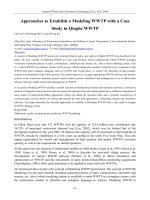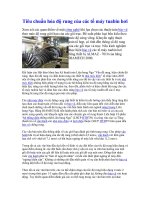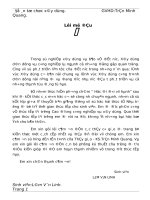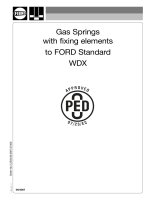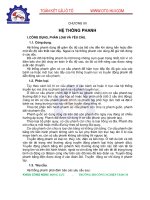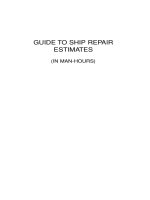TECH TALLY: APPROACHES TO ASSESSING TECHNOLOGICAL LITERACY doc
Bạn đang xem bản rút gọn của tài liệu. Xem và tải ngay bản đầy đủ của tài liệu tại đây (1.22 MB, 379 trang )
Committee on Assessing Technological Literacy
Elsa Garmire and Greg Pearson, Editors
APPROACHES TO
ASSESSING
TECHNOLOGICAL
LITERACY
TECH TALLY
ii
NATIONAL ACADEMIES PRESS • 500 Fifth Street, N.W. • Washington, DC 20001
NOTICE: The project that is the subject of this report was approved by the Governing Board of the National
Research Council, whose members are drawn from the councils of the National Academy of Sciences, the National
Academy of Engineering, and the Institute of Medicine. The members of the committee responsible for the report
were chosen for their special competences and with regard for appropriate balance.
This study was supported by Contract/Grant No. ESI-0138715 between the National Academy of Sciences and the
National Science Foundation. Any opinions, findings, conclusions, or recommendations expressed in this publica-
tion are those of the author(s) and do not necessarily reflect the views of the organizations or agencies that provided
support for the project.
Library of Congress Cataloging-in-Publication Data
Tech tally : approaches to assessing technological literacy / Committee on Assessing
Technological Literacy in the United States ; Elsa Garmire and Greg Pearson, editors.
p. cm.
Includes bibliographical references and index.
ISBN 0-309-10183-2 (hardcover) — ISBN 0-309-66003-3 (pdf) 1. Technical education—
United States—Evaluation. 2. Technological literacy—United States. I. Garmire, E.
II. Pearson, Greg. III. National Academy of Engineering. Committee on Assessing
Technological Literacy in the United States. IV. Title.
T73.T4165 2006
609.73—dc22
2006019673
Additional copies of this report are available from National Academy Press, 2101 Constitution Avenue, N.W.,
Lockbox 285, Washington, DC 20055; (800) 624-6242 or (202) 334-3313 (in the Washington metropolitan area);
Internet, .
Copyright 2006 by the National Academy of Sciences. All rights reserved.
Printed in the United States of America
iii
The National Academy of Sciences is a private, nonprofit, self-perpetuating society
of distinguished scholars engaged in scientific and engineering research, dedicated to
the furtherance of science and technology and to their use for the general welfare.
Upon the authority of the charter granted to it by the Congress in 1863, the Academy
has a mandate that requires it to advise the federal government on scientific and
technical matters. Dr. Ralph J. Cicerone is president of the National Academy
of Sciences.
The National Academy of Engineering was established in 1964, under the charter of
the National Academy of Sciences, as a parallel organization of outstanding engineers.
It is autonomous in its administration and in the selection of its members, sharing with
the National Academy of Sciences the responsibility for advising the federal govern-
ment. The National Academy of Engineering also sponsors engineering programs
aimed at meeting national needs, encourages education and research, and recognizes
the superior achievements of engineers. Dr. Wm. A. Wulf is president of the National
Academy of Engineering.
The Institute of Medicine was established in 1970 by the National Academy of
Sciences to secure the services of eminent members of appropriate professions in the
examination of policy matters pertaining to the health of the public. The Institute acts
under the responsibility given to the National Academy of Sciences by its congres-
sional charter to be an adviser to the federal government and, upon its own initiative,
to identify issues of medical care, research, and education. Dr. Harvey V. Fineberg is
president of the Institute of Medicine.
The National Research Council was organized by the National Academy of Sciences
in 1916 to associate the broad community of science and technology with the Academy’s
purposes of furthering knowledge and advising the federal government. Functioning
in accordance with general policies determined by the Academy, the Council has
become the principal operating agency of both the National Academy of Sciences and
the National Academy of Engineering in providing services to the government, the
public, and the scientific and engineering communities. The Council is administered
jointly by both Academies and the Institute of Medicine. Dr. Ralph J. Cicerone and
Dr. Wm. A. Wulf are chair and vice chair, respectively, of the National Research Council.
www.national-academies.org
iv
Committee on Assessing
Technological Literacy
ELSA GARMIRE, chair, Dartmouth College, Hanover, New Hampshire
RODGER BYBEE, Biological Sciences Curriculum Study, Colorado
Springs, Colorado
RODNEY L. CUSTER, Illinois State University, Normal
MARTHA N. CYR, Worcester Polytechnic Institute, Worcester,
Massachusetts
MARC J. de VRIES, Eindhoven University of Technology, Eindhoven,
The Netherlands
WILLIAM E. DUGGER JR., International Technology Education
Association, Blacksburg, Virginia
ARTHUR EISENKRAFT, University of Massachusetts Boston
J. DEXTER FLETCHER, Institute for Defense Analyses, Alexandria,
Virginia
ALAN J. FRIEDMAN, New York Hall of Science, Queens
RICHARD KIMBELL, University of London, New Cross, London,
United Kingdom
JOSÉ P. MESTRE, University of Illinois, Champagne-Urbana
JON D. MILLER, Northwestern University Medical School,
Chicago, Illinois
SUSANNA HORNIG PRIEST, University of South Carolina,
Columbia
SHARIF SHAKRANI, National Assessment Governing Board,
Washington, D.C.
JOHN D. STUART, PTC, Needham, Massachusetts
MARY YAKIMOWSKI-SREBNICK, Yakimowski and Associates and
Council of Chief State School Officers, Suffolk, Virginia
Project Staff
GREG PEARSON, Study Director and Program Officer, National
Academy of Engineering
STUART ELLIOTT, Director, Board on Testing and Assessment,
National Research Council (June 2003 to project end)
PASQUALE DEVITO, Director, Board on Testing and Assessment,
National Research Council (October 2002 to May 2003)
v
CAROL R. ARENBERG, Senior Editor, National Academy
of Engineering
MARIBETH KEITZ, Senior Public Understanding of Engineering
Associate, National Academy of Engineering (April 2003 to
project end)
MATTHEW CAIA, Senior Project Assistant (October 2002 to
March 2003)
EILEEN GENTLEMAN, Christine Mirzayan Science and
Technology Policy Graduate Fellow (January 2005 to March 2005)
STEVE MEYER, Christine Mirzayan Science and Technology Policy
Intern (September 2002 to November 2002)
ROBERT POOL, Freelance Writer
vi
NAE Council Committee on Programs
LAWRENCE PAPAY, chair, Science Applications International
Corporation (retired), La Jolla, California
RAY BEEBE, Homestake Mining Company (retired), Tucson Arizona
W. DALE COMPTON, Purdue University, West Lafayette, Indiana
RUTH DAVIS, Pymatuning Group Inc., Alexandria, Virginia
ELSA GARMIRE, Dartmouth College, Hanover, New Hampshire
ELISABETH PATÉ-CORNELL, Stanford University, Stanford,
California
JOHN SLAUGHTER, National Action Council for Minorities in
Engineering, White Plains, New York
WM. A. WULF,* National Academy of Engineering, Washington, D.C.
Staff
PROCTOR REID, Director, NAE Program Office
*Ex Officio.
vii
Board on Testing and Assessment
LAURESS L. WISE, chair, Human Resources Research Organization,
Alexandria, Virginia
LYLE BACHMAN, University of California, Los Angeles
EVA L. BAKER, Center for the Study of Evaluation, University of
California, Los Angeles
STEPHEN B. DUNBAR, University of Iowa, Iowa City
DAVID J. FRANCIS, University of Houston, Houston, Texas
MILTON D. HAKEL, Bowling Green State University, Bowling
Green, Ohio
ANDREW J. HARTMAN, Bell Policy Center, Denver, Colorado
ROBERT M. HAUSER, NAS, University of Wisconsin-Madison
DANIEL M. KORETZ, Harvard University, Cambridge,
Massachusetts
EDWARD P. LAZEAR, Stanford University, Stanford, California
RICHARD J. LIGHT, Harvard University, Cambridge, Massachusetts
ROBERT J. MISLEVY, University of Maryland, College Park
MICHAEL NETTLES, Educational Testing Service, Princeton,
New Jersey
JAMES W. PELLEGRINO, University of Illinois, Chicago
DIANA C. PULLIN, Boston College, Chestnut Hill, Massachusetts
LORETTA A. SHEPARD, University of Colorado, Boulder
Staff
STUART W. ELLIOTT, Director
LISA D. ALSTON, Administrative Coordinator
ix
Preface
T
his report is the final product of a two-year study by the
Committee on Assessing Technological Literacy, a group
of experts on diverse subjects under the auspices of the
National Academy of Engineering (NAE) and the Board on Testing and
Assessment at the Center for Education, part of the National Research
Council (NRC). The committee’s charge was to determine the most
viable approach or approaches to assessing technological literacy in U.S.
K–12 students, K–12 teachers, and out-of-school adults. To fulfill that
charge, the committee considered opportunities and obstacles to develop-
ing one or more scientifically valid and broadly applicable assessment
instruments for technological literacy in the three target populations and
specified subtest areas and sample test items for such assessments.
This report is based on Technically Speaking: Why All Americans
Need to Know More About Technology, a 2002 publication by the National
Academies, in which technological literacy was defined and a case was
made for its importance. A key finding of that report was that few data are
available about what Americans—children or adults—know and can do
with respect to technology. The general feeling, then as now, was that
people in this country are poorly prepared to think critically about many
important technological issues—from the safety of genetically modified
foods to privacy concerns raised by post-9/11 data gathering to the value
and risks of a new manned mission to the moon. But without valid and
reliable data from assessments, developing an effective strategy for im-
proving the situation is all but impossible. The present report is intended
to provide a road map for organizations and individuals to begin to fill this
data gap.
The Committee on Assessing Technological Literacy adopted
the broad definition of technology used in Technically Speaking. Technol-
ogy includes not only the tangible artifacts of the human-designed world
and the systems of which these artifacts are a part, but also the people,
infrastructure, and processes required to design, manufacture, operate,
and repair the artifacts. This comprehensive definition differs markedly
from the more common, narrower public view, in which technology is
almost exclusively associated with computers and other electronics.
This report will be of special interest to individuals and groups
promoting technological literacy in the United States or developing or
using the results of assessments in the domain of technology. Education
and government policy makers in federal and state agencies, as well as the
education research community, will also find much to think about. At the
policy level, growing concerns about the competitiveness of the U.S.
science and engineering workforce have highlighted the need for putting
more emphasis on what people—particularly K–12 students—know and
can do with respect to technology. For researchers, efforts to investigate
the dimensions of technological literacy have revealed a largely unexplored
territory related to how children and adults learn technological concepts
and how computer-based simulation might be used as an assessment tool.
The committee met seven times, sponsored one stakeholders’
workshop, and talked informally with a number of nationally recognized
experts on assessment, cognition, and related areas. The workshop, held
September 2004, brought together more than 20 individuals representing
public and private assessment organizations; technology-based industries;
classrooms, schools, and school systems; and researchers interested in
workforce and employment. The committee also received critical input
from workshop participants.
Two reviews of the literature were commissioned, one on how
people learn technology-related concepts and the other on how people
learn engineering-related concepts. The committee also commissioned an
analysis of data from the long-term science assessment conducted as part
of the National Assessment of Educational Progress. The panel collected
and reviewed some 30 assessment instruments on various aspects of tech-
nological literacy. Finally, beyond this data gathering, the report also
reflects the personal and professional experiences and judgments of com-
mittee members.
For better or worse, we live in a numbers-oriented world, in
education as well as other sectors. Many people can only be convinced of
PREFACE
x
the need for greater technological literacy if the argument can be backed
by hard data. For a variety of reasons, gathering such data will not be easy,
but it is important that we do so. This report provides a solid platform
from which to launch the effort.
Elsa M. Garmire, chair
Committee on Assessing Technological Literacy
PREFACE
xi
xiii
Acknowledgments
T
his report has been reviewed in draft form by individuals
chosen for their diverse perspectives and technical ex-
pertise, in accordance with procedures approved by the
NRC’s Report Review Committee. The purpose of this independent
review is to provide candid and critical comments that will assist the
institution in making its published report as sound as possible and to
ensure that the report meets institutional standards for objectivity, evi-
dence, and responsiveness to the study charge. The review comments and
draft manuscript remain confidential to protect the integrity of the delib-
erative process. We wish to thank the following individuals for their
review of this report:
Philip Bell, Cognitive Studies in Education, University
of Washington
Christopher T. Cross, Chairman’s Office, Cross & Joftus, LLC
Sharon Dunwoody, School of Journalism and Mass
Communication, University of Wisconsin-Madison
Paul Fleury, School of Engineering, Yale University
Joan Herman, Center for Research on Evaluation, Standards,
and Student Testing, University of California, Los Angeles
Marie Hoepfl, Department of Technology, Appalachian
State University
Brett D. Moulding, Science Education and Curriculum, Utah
Office of Education
Nancy S. Petersen, Measurement and Statistical Research,
ACT Inc.
John M. Rauschenberger, Personnel Research and
Development, Ford Motor Company
Larry Snyder, Department of Computer Science, University
of Washington
Mark Wilson, Graduate School of Education, University
of California, Berkeley
Although the reviewers listed above have provided many con-
structive comments and suggestions, they were not asked to endorse the
conclusions or recommendations nor did they see the final draft of
the report before its release. The review of this report was overseen by
Lauress Wise, President’s Office, Human Resources Research Organiza-
tion (HumRRO) and William G. Agnew, Retired Director, Programs
and Plans, General Motors Corporation. Appointed by the National
Research Council, they were responsible for making certain that an
independent examination of this report was carried out in accordance
with institutional procedures and that all review comments were carefully
considered. Responsibility for the final content of this report rests en-
tirely with the authoring committee and the institution.
In addition to the reviewers, many other individuals assisted in
the development of this report. Stephen Petrina, at the University of
British Columbia, and Alisha Waller, at Georgia State University, con-
ducted extensive reviews of the literature reviews on behalf of the commit-
tee. Larry O. Hatch, at Bowling Green State University, performed a
detailed analysis of data on long-term trends from the National Assess-
ment of Educational Progress science assessment. Project evaluators
Patricia Bourexis and Senta Raizen, at The Study Group Inc., provided a
valuable analysis of input from the workshop. Dan Householder, at the
National Science Foundation, provided patient and wise guidance through-
out the project. And participants in the committee’s workshop and other,
informal information-gathering activities supplied much-needed perspec-
tives on the topics under consideration.
Thanks are also due to the project staff. Matthew Caia provided
administrative support during the early phases of the project. Maribeth
Keitz ably managed the bulk of the logistical and administrative needs,
making sure meetings and workshops ran efficiently and smoothly. Chris-
tine Mirzayan Science and Technology Policy Intern Steve Meyer helped
create a Web-based system for recording information about the assess-
ment instruments the committee collected, and Christine Mirzayan Science
ACKNOWLEDGMENTS
xiv
and Technology Policy Graduate Fellow Eileen Gentleman prepared
summaries of those documents. Freelance writer Robert Pool helped write
the introductory chapters. NAE Senior Editor Carol R. Arenberg sub-
stantially improved the readability of the report. Special thanks are due to
Pasquale Devito, head of the NRC Board on Testing and Assessment,
who helped guide the project at its inception, and to his successor, Stuart
Elliott, who provided insights and advice throughout the study process.
Greg Pearson, at NAE, played a key role in conceptualizing the study and
managed the project from start to finish.
ACKNOWLEDGMENTS
xv
xvii
Contents
EXECUTIVE SUMMARY 1
1 INTRODUCTION 19
How Technologically Literate Are We?, 20
Benefits of Assessing Technological Literacy, 22
Obstacles to Assessing Technological Literacy, 24
Charge to the Committee, 25
References, 27
2 DEFINING TECHNOLOGICAL LITERACY 29
The Designed World, 30
Technological Literacy, 32
Attitudes Toward Technology, 36
Visualizing Technological Literacy, 37
Assessing Technological Literacy, 38
References, 39
3 ASSESSMENT AS A DESIGN CHALLENGE 41
The Design Process, 41
Imperfect Design, 59
Inherent Uncertainties, 60
References, 60
xviii
4 AN ASSESSMENT PRIMER 63
Testing and Measurement, 64
Cognition, 72
Research on Technological Learning, 80
References, 86
5 REVIEW OF INSTRUMENTS 93
Mapping Existing Instruments to the
Dimensions of Technological Literacy, 98
Attitudes Toward Technology, 113
Filling the Assessment Matrix, 115
References, 124
6 FROM THEORY TO PRACTICE:
FIVE SAMPLE CASES 127
Case 1: Statewide Grade-Level Assessment, 129
Case 2: Matrix-Sample Assessment of 7th Graders, 136
Case 3: National-Sample Assessment of Teachers, 140
Case 4: Assessments for Broad Populations, 146
Case 5: Assessments for Visitors to Museums and
Other Informal-Learning Institutions, 153
References, 158
7 COMPUTER-BASED ASSESSMENT METHODS 161
Computer-Based Adaptive Assessments, 162
Simulations, 164
Computer-Based and Web-Based Games, 168
Electronic Portfolios, 170
Electronic Questionnaires, 171
References, 172
8 FINDINGS AND RECOMMENDATIONS 175
Opportunities for Assessment, 176
Research on Learning, 186
Innovative Measurement Techniques, 188
Framework Development, 190
Definition of Technology, 192
Conclusion, 193
References, 195
CONTENTS
xix
APPENDIXES
A Committee Biographies 197
B Technology-Related Standards and Benchmarks in the
National Science Education Standards, Benchmarks for
Science Literacy, and Standards for Technological Literacy 207
C Challenges and Opportunities for Assessing Technological
Literacy in the United States (Workshop Agenda) 251
D Research on Learning in Technology and
Engineering: A Selected Bibliography 255
E Instrument Summaries 265
CONTENTS
1
Executive Summary
I
n a broad sense, technology is any modification of the
natural world made to fulfill human needs or desires.
Although people tend to focus on the most recent techno-
logical inventions, such as computers, cell phones, and the Internet,
technology also includes automobiles, frozen food, irrigation systems,
manufacturing robots, and a myriad of other devices and systems that
profoundly affect everyone in a modern society.
Because of the pervasiveness of technology, an understanding of
what technology is, how it works, how it is created, how it shapes society,
and how society influences technological development is critical to in-
formed citizenship. Technological choices influence our health and eco-
nomic well-being, the types of jobs and recreation available, even our
means of self-expression. How well citizens are prepared to make those
choices depends in large part on their level of technological literacy.
The National Science Foundation (NSF) has been involved in
raising public awareness of the need for an understanding of technology
since the 1980s (Bloch, 1986). More recently, the American Association
for the Advancement of Science (AAAS, 1990), the International Tech-
nology Education Association (ITEA, 1996), and other organizations
have also called for Americans to become more savvy about technology. A
case for technological literacy has been spelled out in Technically Speaking:
Why All Americans Need to Know More About Technology (NAE and NRC,
2002) and in detailed requirements for the development of understanding
and capabilities related to technology among K–12 students (ITEA, 2000).
No one really knows the level of technological literacy among
people in this country—or for that matter, in other countries. Although
TECH TALLY
2
many concerns have been raised that Americans are not as technologically
literate as they should be (e.g., Rutherford, 2004), these statements are
based on general impressions with little hard data to back them up.
Therefore, the starting point for improving technological literacy must be
to determine the current level of technological understanding and capabil-
ity, which areas require improvement first, and how technological literacy
varies among different populations—children and adults, for instance.
The goal of the Committee on Assessing Technological Literacy
was “to determine the most viable approach or approaches for assessing
technological literacy in three distinct populations in the United States:
K–12 students, K–12 teachers, and out-of-school adults.”
1
The commit-
tee was not asked to develop assessment tools but to point the way toward
their development.
Assessing Technological Literacy
To assess technological literacy, one must have not only a clear
idea of what it is, but also a good deal of knowledge about assessment.
Basically, technological literacy is an understanding of technology at a
level that enables effective functioning in a modern technological society.
For the purposes of this report, the committee defined technological
literacy as having three major components, or dimensions: knowledge,
capabilities, and critical thinking and decision making (Figure ES-1). A
similar three-part model of literacy has been proposed for information
technology (IT) (NRC, 1999).
The “knowledge dimension” of technological literacy includes
both factual knowledge and conceptual understanding. The “capabilities
dimension” relates to how well a person can use technology (defined in its
broadest sense) and carry out a design process to solve a problem. A
technologically literate person should, for example, be able to use an
automobile, a VCR, a microwave, a computer, and other technologies
commonly found in the home or office and should be able to do basic
troubleshooting when necessary. The final dimension—the “critical think-
ing and decision-making dimension”—has to do with one’s approach to
technological issues. For example, when a person with highly developed
critical-thinking and decision-making skills is confronted with a new
1
The original charge, which included K–16 students and teachers, was modified
because the committee was unable to identify opportunities for assessing college
students and faculty (with the exception of pre-service teachers).
Technological
literacy is an
understanding
of technology
at a level that
enables effective
functioning
in a modern
technological
society.
EXECUTIVE SUMMARY
3
FIGURE ES-1 The
three dimensions of
technological literacy.
Source: Adapted from
NAE and NRC, 2002.
Critical Thinking
and Decision Making
Capabilities
Knowledge
Highly
developed
Poorly
developed
Extensive
Limited
technology, he or she asks questions about risks and benefits and can
participate in discussions and debates about the uses of that technology.
The committee does not consider attitude to be a cognitive
dimension in the same way knowledge, capability, and critical thinking
and decision making are. However, a person’s attitude toward technology
can provide a context for interpreting the results of an assessment. In other
words, what a person knows—or does not know—about a subject can
sometimes be correlated with his or her attitude toward that subject.
Although few assessments have been developed for technological
literacy, many good assessment tools have been developed for other sub-
jects, from reading and writing to science and mathematics. Indeed, the
field of assessment is mature in many other domains.
Benefits
Of the many groups that would benefit from the development of
assessments of technological literacy, the most obvious is the formal-
education community. As more and more states move toward adopting
technology-education standards for K–12 students (Meade and Dugger,
2004), schools will have to measure how well they are implementing those
standards. Assessments will provide a gauge of how effectively schools
promote technological literacy and an indication of where improvements
can be made.
TECH TALLY
4
For K–12 students to become technologically literate, their teach-
ers must also become technologically literate. To this end, colleges of
education will need assessment tools to gauge the level of technological
literacy of teachers-in-training. Even teachers of nontechnical subjects
must be technologically literate to make connections between their subject
areas and technology. Many other institutions and organizations—such as
media outlets, museums, government agencies, and associations that rep-
resent industries—would benefit from knowing the level of technological
literacy of their customers, patrons, or target audiences.
Levels and types of technological literacy are bound to differ
among people from different social, cultural, educational, and work back-
grounds. To the extent that these differences put particular people or
groups at a disadvantage (e.g., related to educational or employment
opportunities), technological literacy can be considered a social-justice
issue. Assessment can identify these differences, thus creating opportuni-
ties for lessening them.
However, to make a case for raising the level of technological
literacy, one must first be able to show that the present level is low, which
is difficult to do without a good measure of technological literacy. Until
technological literacy is assessed in a rigorous, systematic way, it is
not likely to be considered a priority by policy makers, educators, or aver-
age citizens.
Existing Assessment Instruments
As a context for discussion, the committee collected examples of
assessments that can measure an aspect of technological literacy, even if
they were not developed for that purpose. Altogether, the committee
identified 28 such instruments, including several developed outside the
United States. About two-thirds target K–12 students, nearly one-third
focus on out-of-school adults, and two are intended for teachers. Most
existing assessments for out-of-school adults tend to focus on awareness,
attitudes, and opinions, rather than on knowledge or capabilities.
The committee concluded that none of these instruments is
completely adequate to the task of assessing technological literacy, because
none of them fully covers the three dimensions spelled out in Technically
Speaking. Most of them emphasize the knowledge dimension, although a
number include items that explore technological capabilities, and a hand-
ful even focus solely on the capability dimension. But very few include the
Levels and types
of technological
literacy are
bound to differ
among people
from different
social, cultural,
educational,
and work
backgrounds.
